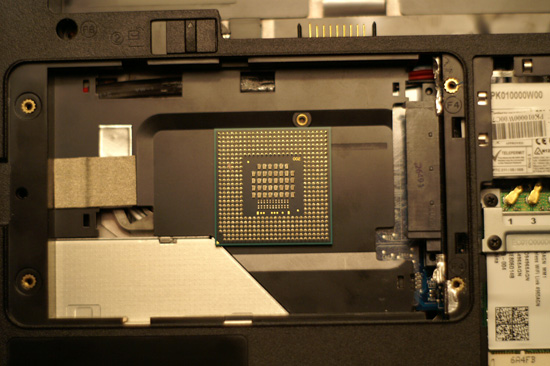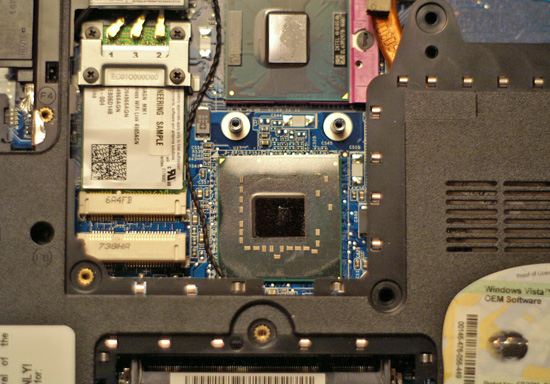Intel Santa Rosa Preview: Centrino V Evolves
by Anand Lal Shimpi on May 10, 2007 12:00 AM EST- Posted in
- Laptops
The Santa Rosa CPU:
As with all Centrino platforms, Santa Rosa is the codename given to a combination of Intel components: CPU, chipset and wireless Ethernet. With Santa Rosa there's a new optional fourth component, now called Intel Turbo Memory but at one point it was known as Robson.

The Santa Rosa CPU is the same 65nm Merom based Core 2 Duo processor that was introduced last year with a few minor changes. The most noticeable change is that Santa Rosa CPUs can support up to an 800MHz FSB, up from 667MHz. The Core 2 Duo is a data hungry CPU, and thus giving it a faster FSB should improve overall performance when plugged in. A faster FSB is also necessary as Intel increases clock speeds; the faster your CPU runs, the faster it needs data to work on in order to operate efficiently.
Along with the 800MHz FSB, Intel introduced SpeedStep technology for its FSB. In previous Centrino platforms, the CPU could throttle its clock speed based on demand by simply adjusting its clock multiplier on the fly. For example, a 2.33GHz mobile Core 2 Duo runs at a 14x multiplier of its 667MHz FSB (166MHz clock frequency x 14.0 multiplier). Under light load, the CPU can reduce its clock multiplier while keeping its FSB frequency the same to reduce power consumption.
With Santa Rosa, Intel can throttle both the CPU multiplier and the FSB frequency in order to conserve the most amount of power when necessary. The FSB frequency can run at a full 800MHz or at 50% of its frequency, 400MHz. The ability to scale back FSB frequency means that idle power of Santa Rosa could actually be much better than previous Centrino platforms.
The product lineup hasn't changed too much with Santa Rosa, there are simply 800MHz FSB mobile Core 2 Duos in the mix now:
Other than that, there are no more changes to the CPU. You already get a good idea that Santa Rosa is the most evolutionary of Centrino platforms we've seen introduced just based on the relatively few improvements made to the CPU. Despite the minor changes to the CPU, Intel has introduced a new socket pinout with Santa Rosa, meaning that these new Merom chips won't work in older platforms and vice versa.
A new, old Chipset:
In Intel's recent tradition, last year's mainstream desktop chipset is now this year's mobile chipset of choice. The Intel 965 Express chipset is now offered in mobile form for use with Santa Rosa, and with it comes updated integrated graphics. As we discovered on the desktop, Intel's G965 graphics performance left a lot to be desired but we are not sure if things have improved since our initial looks at the platform as the test notebook Intel shipped us used discrete graphics.

From a mobile standpoint, the major new feature that the 965 Express chipset brings Centrino is a helpful reduction in power consumption. We originally described the improvement in our IDF coverage last year:
"In the Core 2 Duo's lowest power state, often referred to as Enhanced Deeper Sleep, all data in its cache is flushed to main memory and the cache is powered down to conserve battery life. Otherwise, if the memory controller is still handling memory requests, it will continually wake the processor up looking for data in its cache, even though the cache is empty."
The new 965 chipset goes through a handshaking process with the CPU so it knows when the Core 2 processor's cache has been flushed, thus knowing not to wake it up until it absolutely needs to. It sounds like a simple fix but it should result in reduced power consumption."
Obviously support for the 800MHz FSB is a necessary part of Intel's mobile 965 chipset lineup, but that goes without saying, and DDR2-667 is still the memory of choice for Santa Rosa; we won't see a move to DDR3 until Montevina in 2008. There's nothing more to see here, let's talk about wireless and Robson.
As with all Centrino platforms, Santa Rosa is the codename given to a combination of Intel components: CPU, chipset and wireless Ethernet. With Santa Rosa there's a new optional fourth component, now called Intel Turbo Memory but at one point it was known as Robson.

The Santa Rosa CPU is the same 65nm Merom based Core 2 Duo processor that was introduced last year with a few minor changes. The most noticeable change is that Santa Rosa CPUs can support up to an 800MHz FSB, up from 667MHz. The Core 2 Duo is a data hungry CPU, and thus giving it a faster FSB should improve overall performance when plugged in. A faster FSB is also necessary as Intel increases clock speeds; the faster your CPU runs, the faster it needs data to work on in order to operate efficiently.
Along with the 800MHz FSB, Intel introduced SpeedStep technology for its FSB. In previous Centrino platforms, the CPU could throttle its clock speed based on demand by simply adjusting its clock multiplier on the fly. For example, a 2.33GHz mobile Core 2 Duo runs at a 14x multiplier of its 667MHz FSB (166MHz clock frequency x 14.0 multiplier). Under light load, the CPU can reduce its clock multiplier while keeping its FSB frequency the same to reduce power consumption.
With Santa Rosa, Intel can throttle both the CPU multiplier and the FSB frequency in order to conserve the most amount of power when necessary. The FSB frequency can run at a full 800MHz or at 50% of its frequency, 400MHz. The ability to scale back FSB frequency means that idle power of Santa Rosa could actually be much better than previous Centrino platforms.
The product lineup hasn't changed too much with Santa Rosa, there are simply 800MHz FSB mobile Core 2 Duos in the mix now:
| Intel Core 2 Duo Processor Launch - Santa Rosa Merom | ||||||
| Processor | Core 2 Duo T7700 | Core 2 Duo T7500 | Core 2 Duo T7300 | Core 2 Duo T7100 | Core 2 Duo L7500 | Core 2 Duo L7300 |
| Process Technology |
65nm | 65nm | 65nm | 65nm | 65nm | 65nm |
| Cache Size | 4MB | 4MB | 4MB | 2MB | 4MB | 4MB |
| Enhanced Deeper Step Technology |
Yes | Yes | Yes | Yes | Yes | Yes |
| Processor Speed |
2.40 GHz/ 800 MHz Battery |
2.20 GHz/ 800 MHz Battery |
2.00 GHz/ 800 MHz Battery |
1.80 GHz/ 800 MHz Battery |
1.60 GHz/ 800 MHz Battery |
1.40 GHz/ 800 MHz Battery |
| Voltages | 1.0375 - 1.3V | 1.0375 - 1.3V | 1.0375 - 1.3V | 1.0375 - 1.3V | .9 - 1.2V | .9 - 1.2V |
| Bus Speed | 800MHz | 800MHz | 800MHz | 800MHz | 800MHz | 800MHz |
| TDP | 35W | 35W | 35W | 35W | 17W | 17W |
| Median Average Power | <1.1W | <1.1W | <1.1W | <1.1W | <1.0W | <1.0W |
| Pricing 1Ku | $530 | $316 | $241 | $209 | $316 | $284 |
| . | ||||||
Other than that, there are no more changes to the CPU. You already get a good idea that Santa Rosa is the most evolutionary of Centrino platforms we've seen introduced just based on the relatively few improvements made to the CPU. Despite the minor changes to the CPU, Intel has introduced a new socket pinout with Santa Rosa, meaning that these new Merom chips won't work in older platforms and vice versa.
A new, old Chipset:
In Intel's recent tradition, last year's mainstream desktop chipset is now this year's mobile chipset of choice. The Intel 965 Express chipset is now offered in mobile form for use with Santa Rosa, and with it comes updated integrated graphics. As we discovered on the desktop, Intel's G965 graphics performance left a lot to be desired but we are not sure if things have improved since our initial looks at the platform as the test notebook Intel shipped us used discrete graphics.

From a mobile standpoint, the major new feature that the 965 Express chipset brings Centrino is a helpful reduction in power consumption. We originally described the improvement in our IDF coverage last year:
"In the Core 2 Duo's lowest power state, often referred to as Enhanced Deeper Sleep, all data in its cache is flushed to main memory and the cache is powered down to conserve battery life. Otherwise, if the memory controller is still handling memory requests, it will continually wake the processor up looking for data in its cache, even though the cache is empty."
The new 965 chipset goes through a handshaking process with the CPU so it knows when the Core 2 processor's cache has been flushed, thus knowing not to wake it up until it absolutely needs to. It sounds like a simple fix but it should result in reduced power consumption."
Obviously support for the 800MHz FSB is a necessary part of Intel's mobile 965 chipset lineup, but that goes without saying, and DDR2-667 is still the memory of choice for Santa Rosa; we won't see a move to DDR3 until Montevina in 2008. There's nothing more to see here, let's talk about wireless and Robson.










22 Comments
View All Comments
avaughan - Thursday, May 10, 2007 - link
I would have thought that the real benefit from Robson would have been the power savings from the ability for the OS to write todisk/save something/do a small amount of swapping without needing to spin up the hard disk.
Regarding performance expectations, what's the read/write throughput on the flash, and is this a fast hard disk? I would expect
reading/writing a large contiguous file to/from a fast hard to be faster than reading/writing to cheap (= slow) flash.
If Vista can store part of the data on the hard disk, and the rest on flash, and read/write both chunks simultaneously
or the flash has throughput as fast/faster as the hard disk then I would hope to see performance benefits.
smn198 - Thursday, May 10, 2007 - link
Maybe it was an interesting article but I cannot read the begining of each line as there are Intel vPro dogs in the way.